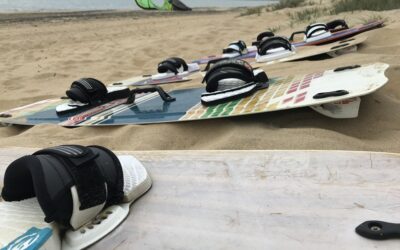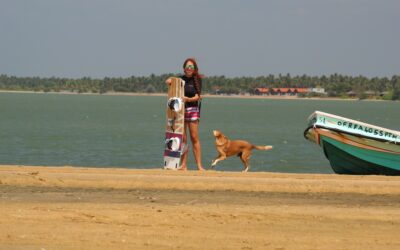Is kitesurfing dangerous?
Kitesurfing has become one of our favourite extreme sports to enjoy on the beach in summer. As its practise has expanded considerably in recent years, the number of accidents has also increased. That is why we ask ourselves, is kitesurfing dangerous? Let´s give you a basic idea about this topic.
Fans of this kitesurfing, considered risky, can reach a speed over the water of around 50 knots (approximately 100 km / h) so that a mishap can cause severe consequences for the kiter or the people everywhere. According to a study carried out by the Department of Circulation and Sports Sciences of the University of Ghent (Belgium, 2011), every 1,000 hours of practice there are almost 17 accidents that result in: injuries to the lower extremities, followed by those produced in the upper extremities, the trunk, the head and, to a lesser extent, damage to third parties or cause death. Most of these accidents are attributed to the inability to separate the kite from the harness.
With all of that, can we say that kitesurfing is a dangerous sport? Well, in our opinion, as in all extreme sports, kitesurfing has some inherent risks to take into account, but we wouldn´t call it dangerous.
Then, why some people say that kitesurfing in dangerous? It is because of the inherent risks that you incur when doing kite. Let´s also remark that the word “dangerous” is entirely subjective. For what is dangerous for some people, for others, it is merely risky.
As a kitesurfing school, we do not consider kitesurfing to be a dangerous sport as long as it is practised safely and with the proper safety measures.
As in all extreme sports, injuries occur in kitesurfing. What differentiates them from other extreme sports is that they can be severe and, in some cases, with a fatal outcome.
Among the most frequent causes of these injuries, there are technical errors due to the kiter inexperience. However, the excess of wind is another primary cause of some fatal injuries.
There are not many articles in the medical literature that have been devoted to analyzing injuries associated with kitesurfing. Those that we have been able to review agree that the incidence of injuries in this sport is proportionally higher than in most.
In kitesurfing, the most frequent injuries are caused by a loss of control of the kite, due to its excessive size (at least for our condition and physical size), lack of caution, technical errors or powerful wind. In more than half of the cases the crash can be reduced – and even avoided – if the power of the kite is quickly reduced or you unhook the safety ring that connects the depositor to it.
Basic tips to minimize the dangers of Kitesurfing
Here we give you some tips to kite safely and without any dangers.
– Any activity that requires the use of material for its practice, from golf to kitesurfing, requires a learning curve. It is necessary to be tutored by experts who will teach you everything we need to know to practice this sport safely. It would be best if you did not do it on our own.
-You must not kite too far from the coast, but neither should your kite too close to the coast because you could become a danger to bathers.
-Do not jump in shallow places. In this way, you will avoid hitting bottom with the consequent risk of head or neck injury.
-Use a quick-release system in case we lose control of the kite, to be able to get rid of it without dragging you.
-Wear a helmet and protective vest. Essential when we are newbies, but it is not too much if we carry it continuously. You never know.
-The kite must have the appropriate measurements for the kiter’s anatomy and size.
-Watch out for other kiters in our area. It would be best if you respected navigation preference to avoid collisions and potentially dangerous situations.
– Practice it in a company: As in all risk sports, we recommend to practice it in a company or under the supervision of others, in case any incident arises that could even incapacitate the kiter, requiring assistance from third parties.
– Do not practice kitesurfing in stormy weather: Kites attract lightning, so it can be hazardous to practice this sport when there are bad weather conditions.
– Have insurance: It is essential to take out kitesurf insurance that adapts to the needs of the athlete for their safety and that of all bathers. In this way, you will have the peace of mind of being protected in the event of an incident by having the appropriate coverage, such as compensation for death and accident, medical assistance and treatment, civil liability and worldwide coverage.


How much does kitesurfing equipment cost?
For many people who are new to kitesurfing and want to learn, a commonly asked question is how much kitesurfing gear costs. However, the answer to this question is not a straightforward one - The price of kitesurfing equipment varies between items and even between...
Kite gear maintenance: best practices for a long life of your kitesurfing equipment
Have you just started in the sport and still don't know very well how to keep your kitesurfing equipment in the best conditions? Your Kitesurfing equipment is very important, and if you love it and you want it to last for a long time, you must maintain it in the best...
The ultimate guide to beginner kitesurfing boards
Have you finished your kite course and you don't know which initiation board is the most suitable for beginners? In this post, we will help you to choose the best beginners kitesurfing boards and the ones which you can progress faster. There is always a hard time in...
The most dangerous situations = What you should never do in Kitesurfing
Apart from the forehead advice, here you have a list with the TOP things you should never do if you don´t want kitesurfing to be dangerous. When we talk about the dangers of kitesurfing these are the most important things you should take care:
1. Learning kiteboarding without a certified instructor it is probably the most dangerous thing to do. Trying to learn by yourself or with a beginner friend in kitesurfing is the first step towards the hospital. Kitesurfing is not a high-risk sport if all precautionary measures are taken and this is the worst choice to start in kitesurfing
2. Kiteboarding in prohibited areas or in areas with rocks or other nearby obstacles. Also, it is quite dangerous to kite on beaches where there are many bathers. Always look at what is in the direction of the wind, since if we lose control, we will go there, it is therefore essential that we always look for clean areas downwind of us.
3. Kiteboarding on days where the wind conditions exceed our level. It is essential to know your limitations and go step by step.
4. Kiteboarding with larger kites than those required at that time due to the force of the wind. If you want to minimize the dangers of being overpowered, better you choose a smaller kite rather than a larger kite according to the wind conditions. A day without kiteboarding is better than three months due to an injury.
5. Kiteboarding alone or in unknown places.
6. Kiteboarding with gusty or off-shore winds.
7. Holding the lines of the kite with your hands. You should never do this as it is extremely dangerous. If the kite falls, you should ask for help but never touch the lines with your hands. In case the kite falls in the water, and you cannot relaunch it, you have to collect the lines with the bar, gradually approaching the kite. Never cross the lines of a moving kite. Their material is so strong that they support up to 300 kilos and are incredibly sharp in the air.
Conclusion
Kitesurfing is not dangerous when you know what you are doing and you evaluate the risks. We know that the adrenaline in your veins is “fuck…ing” awesome, but remember that if you don´t care about the risks, you can end up with a broken leg or even worst. That is why it is essential to take a course to learn and control the technique correctly. Kitesurfing is a booming sport that is available to everyone, but you cannot forget the importance of the correct conditions. The wind and the sea are two uncontrollable natural environments where you can reach up to 100 km / h with the risks that this entails.
Flying a kite close to bathers, breakwaters, beach bars, or beach planes is extremely dangerous. Currently, there are limited and authorized areas to practice this sport safely. Also in order, you will need the right equipment that includes a helmet, flotation vest, anemometer, neoprene clothing and even booties.
And lastly, as we have seen above, before going out to sea it is essential to check the lines, bars, kite, harness to check that they are in perfect condition and if they adapt to the area where you will kite since sometimes the place and the weather conditions determine that the material has specific dimensions.
We hope you enjoy kitesurfing safely and without dangers!
Kite foiling vs wing foiling. What are the main differences?
Differences Between Kitefoiling and Wingfoiling: Which One Is Right for You? Are you a water sports enthusiast looking to try something new? If so, you may be wondering about the differences between kitefoiling and wingfoiling. Both activities involve riding a...
Kitesurfing Camps for Beginners
Discover the Excitement of Kitesurfing Camps for Beginners Welcome, aspiring kitesurfers, to the thrilling world of kitesurfing camps for beginners! If you've ever dreamt of harnessing the power of the wind, riding the waves, and experiencing the ultimate adrenaline...
Kitesurfing for girls & women, everything you need to know!
Do you know that only 10% of the kitesurfers around the world are female? Recent statistics show that around 49.48% of the world population consists of women. So based on that, it seems that the number of women who kitesurf is very low! The reason for this low...
The best kitesurfing spots in the world
"From Asia to America, from East to West. Explore some of the world's finest kitesurfing spots. And, no sharks!" Maybe you’ve been kitesurfing for a while, and want to try exciting new waters? Holidays to famous kitesurfing destinations around the world is all part of...
The ultimate guide with the top kitesurfing spots in Asia
If there’s one sport that can enthral your senses and make you feel more attached to the beautiful nature, it’s kitesurfing. The kitesurfing community is moving towards a new goldmine for surfing. Asia, though underrated, is home to some of the best kitesurfing spots....
The ultimate guide with the top flatwater kitesurfing destinations
Best places in the world to kite in flat water Be it surfing over the clearest of waters or performing gravity-defying stunts near the dock, kitesurfing, and its adrenaline boost is unrivalled. A passionate alliance of wind and water, kitesurfing provides...
The ultimate guide with the top kitesurfing destinations to learn kitesurf
Best Places to Learn to Kitesurf There are not many things in this world that can give the same adrenaline rush, as the exhilarating experience of kitesurfing. Harnessing the wind’s power to glide across the water surface, and be lifted high into the sky, is...












